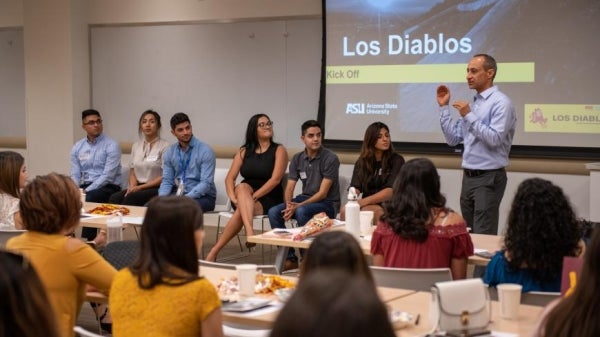ASU awarded $380K Mellon Foundation grant to design and develop inclusive library print collections

Photo by Charlie Leight/ASU Now
Arizona State University has been awarded a $380,000 grant from the Andrew W. Mellon Foundation for a three-year implementation project to reinvent the library’s strategy and practice for open-stack print collections. The work will enable ASU Library to design and develop inclusive library print collections for ASU Library to engage, educate and inspire scholars and learners of the ASU community.
Under the leadership of University Librarian Jim O’Donnell and Associate University Librarian for Collections and Strategy Lorrie McAllister, the project — titled “The Future of the Arizona State University Library Print Collection: A Collaborative and Data-driven Approach to Stack Design and Curation” — follows a yearlong planning process, supported by the Mellon Foundation, in which ASU Library identified issues and options affecting the design of the next generation of open-stack print collection for a research library.
As libraries adapt to new pathways for organizing information and access in the digital age, institutions face the important challenge of preserving print collections in ways that best serve the public. What becomes of the print collection that users see on open shelves in an age when more and more of libraries’ collections are shelved offsite?
Rather than viewing these new forms of access as a threat to print, ASU Library recognizes a vital opportunity to leverage the design and curation practices in ways that engage a broader spectrum of students and scholars in new ways.
“All the scholarly work of the last generation on the history of the book has shown that physical books have always had many functions and complex social dimensions,” said O’Donnell, principal investigator. “Reading a print volume closely and attentively remains a powerful practice for learning and research at every level, but flipping the pages of a print volume in slightly more than idle curiosity remains powerful as well. Print volumes give visibility and visual character to the past and present artifacts of culture. If ‘out of sight, out of mind’ is a true-enough proverb, then what is in sight will be what is in mind — and we can control that in our libraries. How can we best shape the experience of our users in approaching our libraries by the resourceful use of print?”
“ASU is committed to serving a diverse student body and fostering a community wherein the accessibility of education is a guarantee,” said ASU President Michael M. Crow. “We look for ways to unlock access to knowledge and information for the broadest cross-section of students in our community, who in turn reflect the diversity of our surrounding communities. This project will not only create a sustainable model for ASU’s print collections lasting into the future, but it will also extend the depth and breadth of our students’ access to information literacy and tools for independent inquiry.”
The vision for revitalizing public engagement with print comes at a key moment in the university’s plans to renovate its largest library — Hayden Library — and grow student enrollment to 200,000 by the year 2025. As a result, ASU Library must rethink every aspect of its services in order to innovate and scale support for scholars and learners who come from a variety of backgrounds and take many approaches to their education.
“Traditional library practices often indicate the retention of books in open stacks according to highest circulation, English language and authors recognized as being part of the mainstream. ASU seeks to create a local collection designed to inspire and engage our users with more inclusive collections that more accurately reflect the user populations within ASU and our surrounding communities,” said McAllister, co-principal investigator. “We aim to keep our open-stack collections as active, living, growing entities. The books our students see on our shelves should not be treated as furniture, wallpaper or relics not to be touched and used, but as a vital set of tools of sustaining value for the future.”
To learn more about ASU Library’s plans to maximize user engagement around print collections, read the ASU Library white paper The Future of the Academic Library Print Collection: A Space for Engagement.
More University news

Lester Godsey joins ASU as chief information security officer
With a career spanning nearly three decades of professional IT experience, Lester Godsey is back where he first started — serving…

ASU a top-ranked university for graduate employability
Students usually seek higher education degrees to build their skills and aptitude in their chosen vocation, and advance their…

ASU Alumni Association to honor 3 outstanding alumni leaders during Homecoming
The Arizona State University Alumni Association will proudly recognize three innovative alumni leaders during the Homecoming…